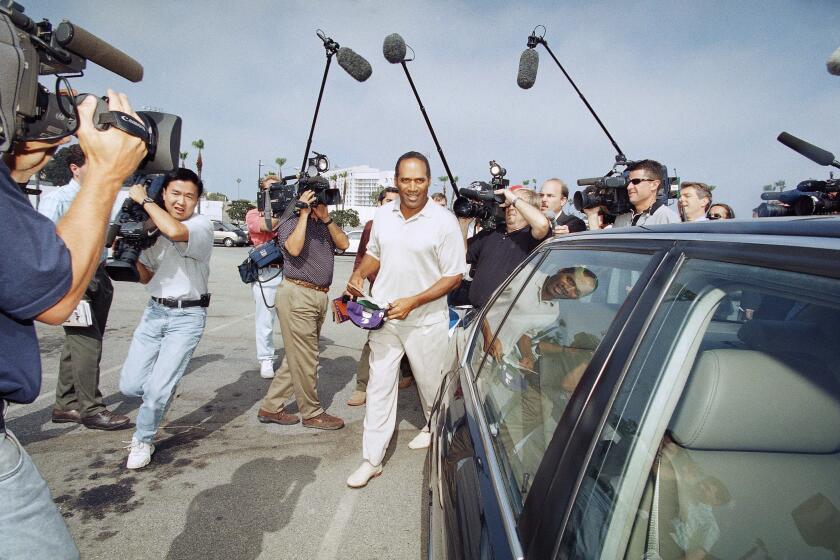Editorial: Trump’s willingness to consider gun control is welcome. But can we believe him?

President Trump brought lawmakers from both parties to the White House on Wednesday to discuss, publicly, the thorny issue of guns in the wake of the Valentine’s Day massacre at a Florida high school. The meeting was most notable for the unexpected interest the president took in tightening gun controls, including expanding background checks to all commercial and internet sales, improving the reporting system that informs the background checks, raising the legal age for buying rifles and other long guns, and making it harder for the mentally ill to possess firearms (though the president lost sight of the Constitution when he said a mentally ill person’s due process rights should come after his or her guns are confiscated). He even seemed willing to discuss reviving a federal ban on assault-style weapons. Unfortunately, he also clung to the absurd notion that school shootings occur because the killers know guns are barred on campuses, so schools should be “hardened” by arming some teachers and staff (there was at least one armed guard on the scene during the shooting in Parkland, Fla.).
Of course, just because Trump utters the words doesn’t mean he’ll stand behind them after the cameras stop rolling. We saw this a few months back when the president seemed flexible on how to restore deportation protections for 700,000 people who have lived in the U.S. illegally since being brought here as children. Negotiations collapsed before the hopes Trump engendered could fully take flight, and there has been no headway on immigration reform or the embattled Deferred Action for Childhood Arrivals program since. So the nation would be wise keep the saltshaker handy on gun control, as well.
We try not to be too cynical about the president’s abilities to lead, though in truth he has shown no indication that he can.
The session was informative, though, in contrasting leadership styles between the current president and the one he replaced. Trump trashed previous presidents (including Barack Obama, his favorite target) for their inability to get Congress to enact stronger gun measures, proclaiming that those seeking better gun control “have a different president now” — as though that alone will counter the political heft of the National Rifle Assn. and the rest of the gun lobby. Obama would have entered such a meeting with a detailed list of policy arguments and a legislative agenda; Trump convened a coffee klatch and spitballed ideas, then essentially told Congress to get busy, as if the 100 senators and 435 members of the House work for him.
We try not to be too cynical about the president’s abilities to lead, though in truth he has shown no indication that he can. Instead, we embrace some of the ideas he seemed to back in the meeting — the assault weapons ban and comprehensive background checks — while rejecting others, especially the absurd notions that the government should “take the guns first, go through due process second,” as Trump put it, and that pistol-packing P.E. teachers will end school shootings.
A more heartening development came from outside the White House meeting: announcements by top retailers that they are rolling back sales of some firearms and ammunition. For example, Dick’s Sporting Goods said that it would “no longer sell assault-style rifles” or high-capacity magazines through its retail subsidiaries, and Dick’s and Walmart both said they would not sell firearms or ammunition to anyone under age 21. Those are admirable steps, though the age restriction raises an interesting complication. If a store sells firearms but refuses to sell to a customer based on age, it may be inviting a discrimination lawsuit by gun rights advocates. That just illustrates that in the long run corporate policies won’t fix this; Congress must.
But will Congress act? Will Trump hold his line, as ill-defined as it is, and actually lead on this issue? Recent history suggests that both are unlikely. It’s worth remembering as well that while the nation focuses on assault-style weapons mowing down children at school, such mass killings are only a small part of our gun violence problem. The truth is, the vast majority of U.S. gun deaths happen by the ones and twos, and often among people who know each other. Reducing ready access to firearms, including handguns, would help reduce the lethality of acts of domestic violence and suicide attempts. Getting rid of the assault-style weapons would help reduce the carnage in mass shootings. But neither will be easy.
Follow the Opinion section on Twitter @latimesopinion or Facebook
More to Read
A cure for the common opinion
Get thought-provoking perspectives with our weekly newsletter.
You may occasionally receive promotional content from the Los Angeles Times.






